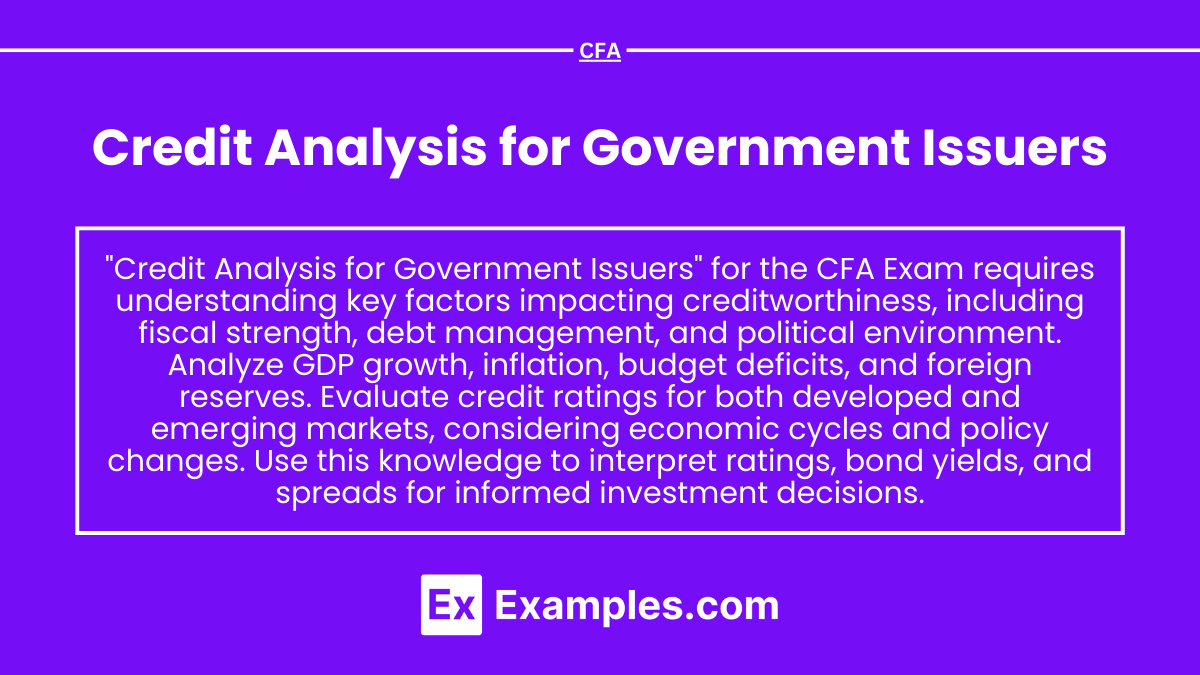Preparing for the CFA Exam requires a solid understanding of credit analysis for government issuers, an essential part of credit risk assessment. Mastery of this topic includes analyzing sovereign creditworthiness, fiscal policies, and economic stability. This knowledge is critical for evaluating government bonds and assessing risks, contributing significantly to a high CFA score.
Learning Objective
In studying “Credit Analysis for Government Issuers” for the CFA Exam, you should develop an understanding of the key factors that impact a government issuer’s creditworthiness, including fiscal strength, economic stability, debt management, and political environment. Analyze sovereign credit risk by assessing indicators like GDP growth, inflation rates, budget deficits, and foreign reserves. Evaluate credit rating methodologies and their application to both developed and emerging markets. Additionally, explore how economic cycles, policy changes, and global events influence government credit profiles. Apply this knowledge to interpret credit ratings, bond yields, and spreads to make informed investment decisions in government securities.
Fiscal Strength and Economic Stability
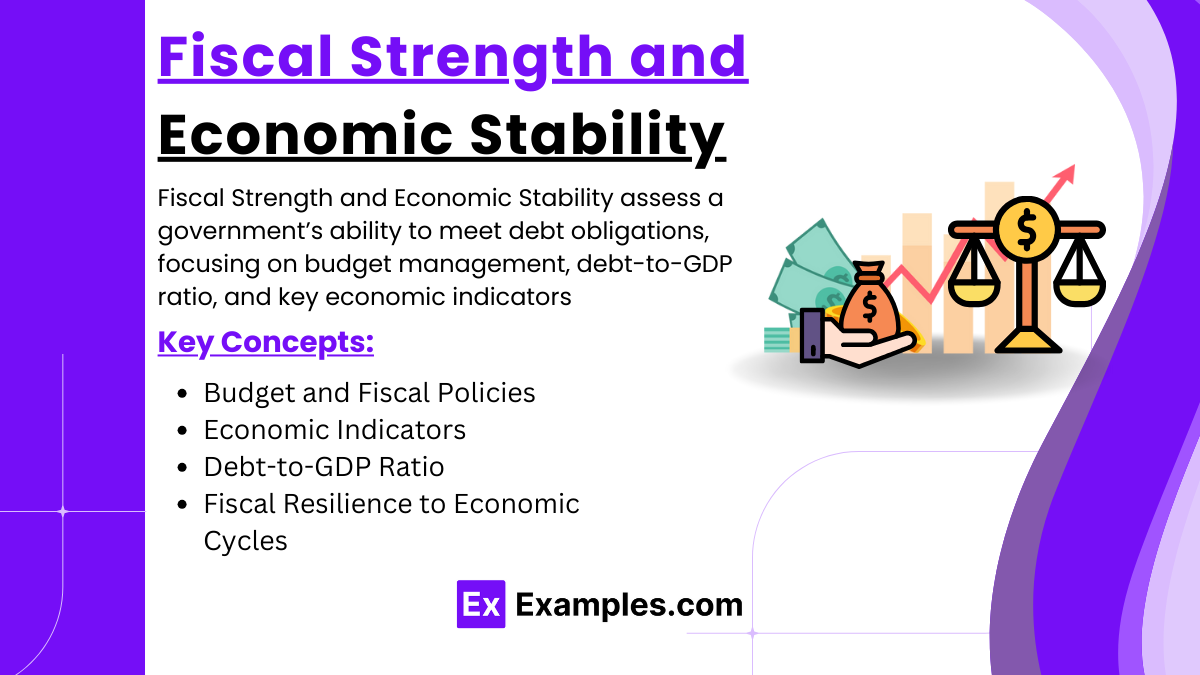
Fiscal Strength and Economic Stability are essential components of credit analysis for government issuers, as they determine a government’s ability to meet its debt obligations reliably. Understanding fiscal strength involves analyzing several key areas:
- Budget and Fiscal Policies: A government’s approach to budgeting—whether it maintains balanced budgets, runs deficits, or achieves surpluses—affects its ability to service debt. A surplus or balanced budget generally indicates fiscal discipline, while persistent deficits can raise concerns about sustainability. Evaluating fiscal policy also involves assessing the government’s spending priorities, revenue sources (such as taxes and trade tariffs), and long-term fiscal plans.
- Economic Indicators: Economic health is crucial in credit analysis. High GDP growth rates indicate economic vitality and suggest that a government can generate sufficient revenue to meet its obligations. In contrast, high inflation or unemployment can signal underlying economic instability, which may increase a government’s credit risk. By examining inflation trends, labor market conditions, and overall economic growth, analysts can gauge a government’s economic resilience.
- Debt-to-GDP Ratio: This metric measures a government’s debt burden relative to the size of its economy. A high debt-to-GDP ratio can signal potential difficulties in managing debt obligations, as it suggests that debt may be growing faster than the economy. Analysts examine this ratio to understand whether debt levels are sustainable given the government’s economic output.
- Fiscal Resilience to Economic Cycles: A government’s ability to manage its finances during different phases of economic cycles—booms and downturns—is another aspect of fiscal strength. Governments with strong fiscal reserves or counter-cyclical policies can better withstand economic downturns without resorting to excessive borrowing, maintaining more stable credit profiles
Debt Management and Structure
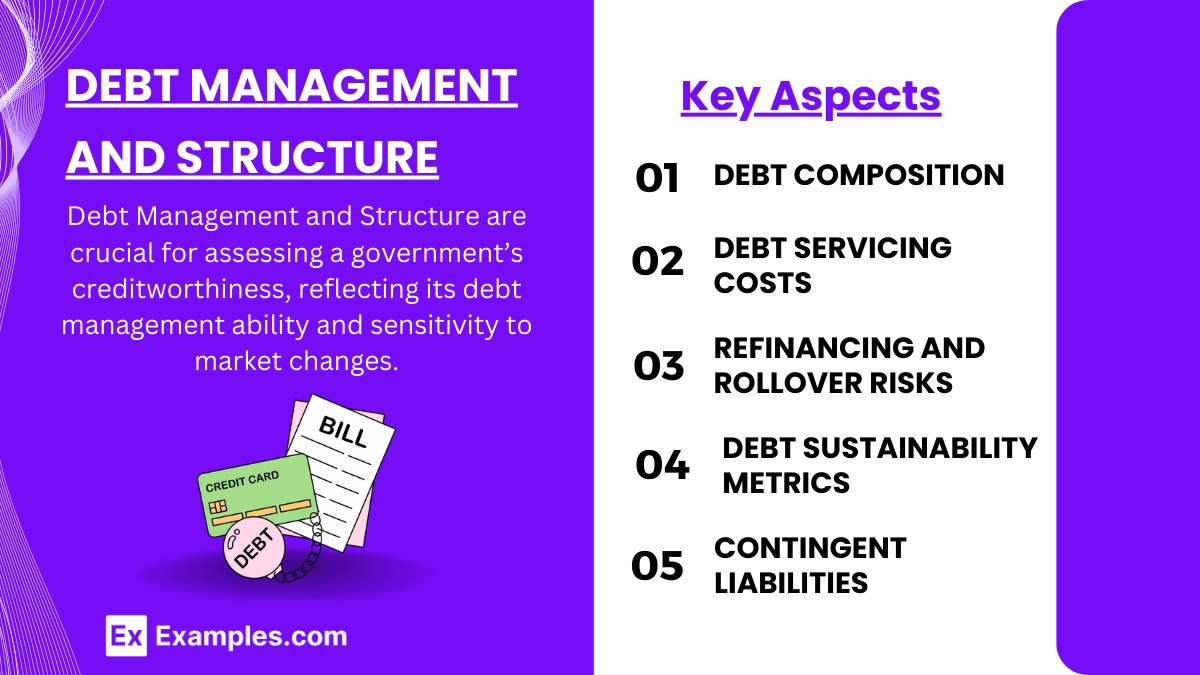
Debt Management and Structure are critical in assessing a government’s creditworthiness, as they reflect how well a government manages its existing debt obligations and its vulnerability to changes in market conditions. This analysis includes the following key aspects:
- Debt Composition: Governments borrow through various debt instruments, including bonds, loans, and treasury bills, which may vary in maturity (short-term vs. long-term) and currency (domestic vs. foreign). A government with a large proportion of short-term or foreign-currency debt may face higher refinancing and currency risks, making it more vulnerable to interest rate changes or exchange rate fluctuations. A well-diversified debt portfolio, including long-term and domestic currency debt, generally signals better debt management.
- Debt Servicing Costs: These costs include interest payments and principal repayments on the government’s debt. High debt servicing costs can consume a significant portion of government revenues, limiting funds available for other priorities like healthcare, infrastructure, and social services. Analyzing debt servicing costs in relation to revenue provides insight into a government’s ability to manage its debt without compromising essential services.
- Refinancing and Rollover Risks: Governments often refinance or roll over debt as it matures by issuing new debt to replace old obligations. A government heavily reliant on short-term borrowing or frequently rolling over debt may face high refinancing risk, especially in adverse economic or market conditions. If market rates increase, a government with significant rollover needs may face rising debt servicing costs, adding pressure to its fiscal position.
- Debt Sustainability Metrics: Key ratios such as debt-to-GDP, interest-to-revenue, and debt-to-revenue are used to assess a government’s debt sustainability. These metrics provide a snapshot of the government’s ability to handle its debt burden relative to its economic output or revenue. Sustainable debt levels suggest a government is unlikely to default, while high or unsustainable levels can signal financial strain.
- Contingent Liabilities: These are potential obligations that the government may have to pay in the future, such as guarantees on private sector loans, pension obligations, or funding for state-owned enterprises. Contingent liabilities can create unexpected financial pressures if they become due, impacting the government’s ability to manage existing debt.
By analyzing these aspects of debt management and structure, credit analysts gain insight into a government’s risk exposure and its ability to service debt in both favorable and challenging conditions. Effective debt management indicates financial discipline and resilience, both of which contribute to a stable credit rating and a stronger credit profile
Political Environment and Governance
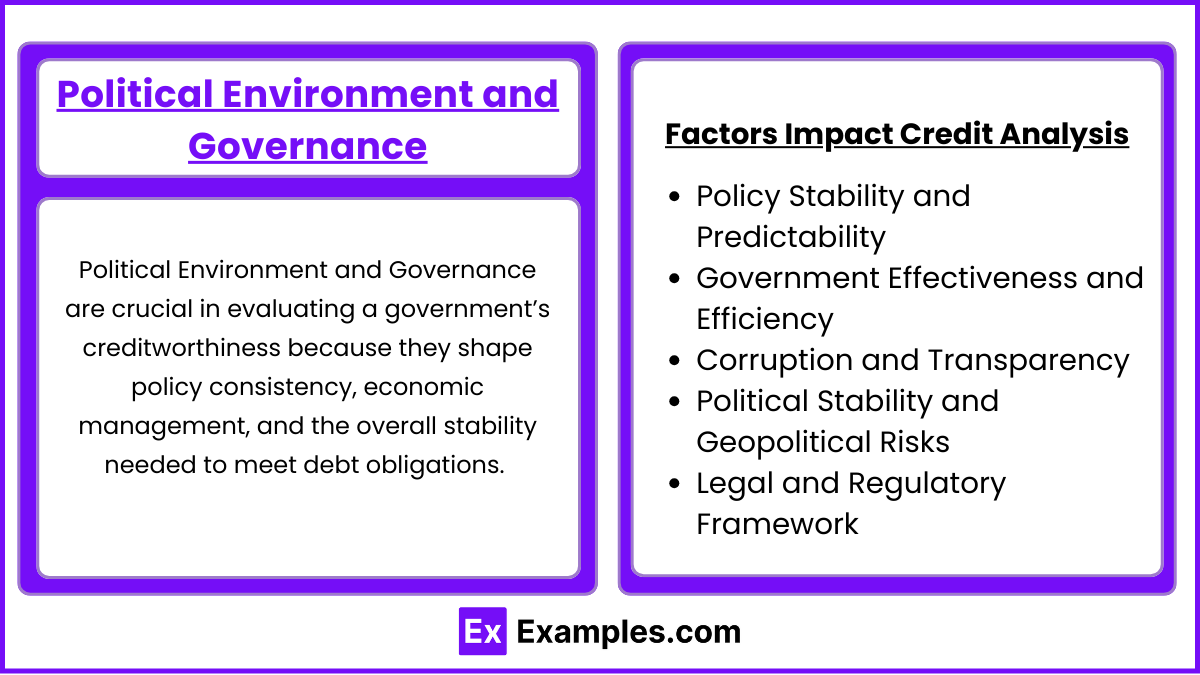
Political Environment and Governance are crucial in evaluating a government’s creditworthiness because they shape policy consistency, economic management, and the overall stability needed to meet debt obligations. Here’s how political and governance factors impact credit analysis:
- Policy Stability and Predictability: A stable political environment reduces the likelihood of abrupt policy changes that could disrupt economic management or investor confidence. When a government frequently changes policies—particularly those related to taxation, spending, and regulatory frameworks—it can create uncertainty, deterring investment and impacting economic growth. Stable, predictable policies signal to investors that the government is committed to maintaining a supportive environment for growth and fiscal responsibility.
- Government Effectiveness and Efficiency: Effective governance indicates that public institutions are well-organized, corruption is minimized, and public sector resources are used efficiently. Governments with strong governance frameworks are better equipped to manage public finances, allocate funds strategically, and meet their debt obligations. High levels of transparency and accountability further strengthen governance, as they build public and investor confidence in the government’s commitment to responsible fiscal management.
- Corruption and Transparency: Corruption can have a significant impact on creditworthiness, as it can drain resources, increase the cost of public projects, and reduce public trust. Governments perceived as highly corrupt may face increased scrutiny and demand for higher yields from investors, as corruption suggests potential misallocation of resources. Transparency, on the other hand, signals that the government is open about its policies, budgets, and financial situation, which reduces perceived risk.
- Political Stability and Geopolitical Risks: Political stability is essential for consistent economic management, as frequent changes in leadership or political unrest can disrupt financial planning and implementation. Governments in regions prone to geopolitical tensions, conflicts, or sanctions face additional risks that can affect their economies, trade, and financial markets. For example, sanctions may restrict a country’s access to international markets, affecting its ability to refinance debt or attract investment. Stable governments with strong geopolitical alliances tend to be viewed more favorably by investors.
- Legal and Regulatory Framework: A sound legal and regulatory environment helps ensure that contracts are enforceable, property rights are protected, and markets operate efficiently. This legal structure is critical for both domestic and foreign investors, as it provides assurances that investments are safeguarded. Weak legal frameworks, on the other hand, increase the risk of arbitrary actions by the government, which can discourage investment and hinder economic growth
Credit Rating and Sovereign Risk Assessment
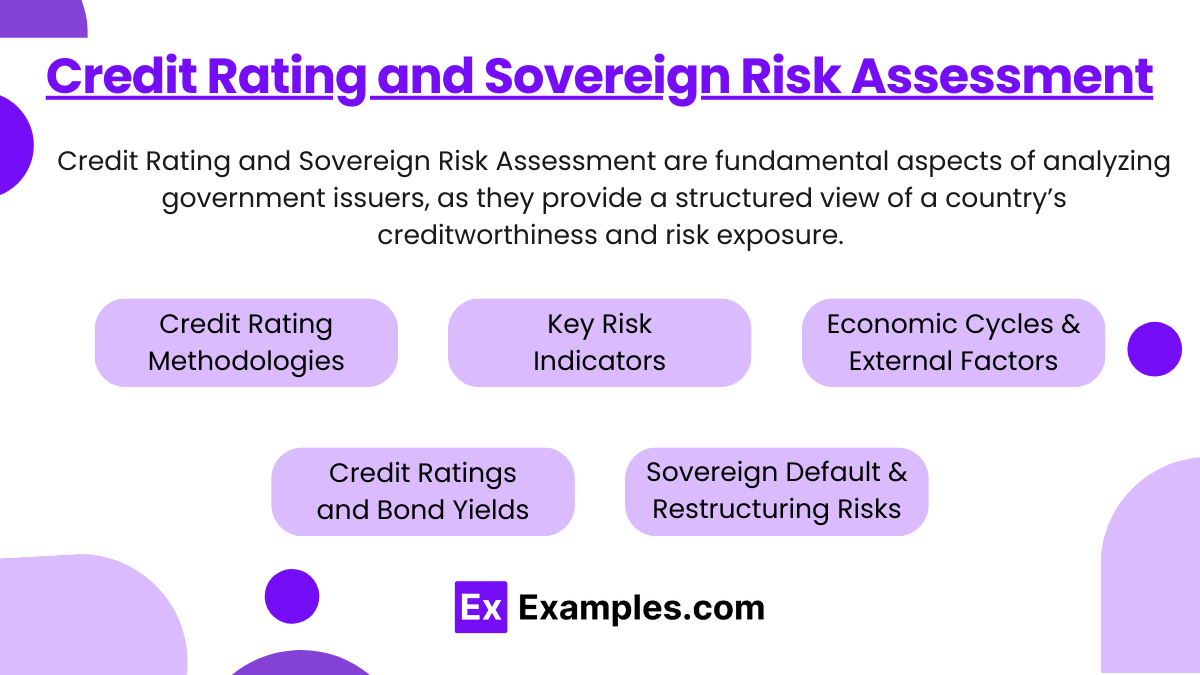
Credit Rating and Sovereign Risk Assessment are fundamental aspects of analyzing government issuers, as they provide a structured view of a country’s creditworthiness and risk exposure. Here’s how these areas influence the assessment:
- Credit Rating Methodologies: Credit rating agencies (like Moody’s, S&P, and Fitch) use specific criteria to assess a government’s financial health and ability to meet its debt obligations. These criteria include economic performance, fiscal stability, debt structure, governance, and susceptibility to external shocks. The ratings assigned—ranging from investment grade to non-investment grade—offer investors an indication of the government’s default risk. Higher-rated governments typically benefit from lower borrowing costs, while lower-rated governments may face higher interest rates or restricted access to capital markets.
- Key Risk Indicators: Sovereign risk assessment involves analyzing critical factors like inflation, budget deficits, external debt levels, foreign currency reserves, and trade balances. High inflation or fiscal deficits may erode a government’s ability to manage its finances, while large foreign reserves and trade surpluses signal greater resilience. Evaluating these indicators helps determine the country’s financial flexibility and capacity to absorb shocks, both of which are essential for creditworthiness.
- Impact of Economic Cycles and External Factors: Sovereign risk assessment includes understanding how economic cycles (such as recessions or booms) and external factors (like commodity prices, trade relationships, and global interest rates) affect a country’s economy. Economies reliant on specific industries, such as oil exports, may be more vulnerable to global price fluctuations. Assessing these external factors helps credit analysts anticipate potential stresses on a government’s finances, which can impact its credit rating.
- Credit Ratings and Bond Yields: Credit ratings have a direct effect on government bond yields and investor perceptions. When a government’s credit rating improves, it signals lower risk, often resulting in lower bond yields as investor confidence grows. Conversely, a credit downgrade can lead to higher yields, as investors demand greater compensation for perceived risk. Investors use credit ratings to determine appropriate investment levels and yields based on the risk-return profile of government-issued bonds.
- Sovereign Default and Restructuring Risks: Assessing sovereign risk also involves evaluating the likelihood of default or the need for debt restructuring. Countries facing severe economic or fiscal stress may resort to restructuring their debt obligations, which can include extending maturities, reducing principal amounts, or renegotiating interest rates. Analysts consider indicators such as rising debt-to-GDP ratios, declining foreign reserves, and political instability as warning signs for potential restructuring risks.
Examples
Example 1
A government with a high debt-to-GDP ratio and persistent budget deficits may face a credit rating downgrade, as these factors indicate a growing debt burden that could limit its ability to service future debt. This was seen when certain European countries experienced downgrades during the sovereign debt crisis due to high debt ratios and economic instability.
Example 2
A government with a high percentage of foreign-currency-denominated debt may be vulnerable to exchange rate fluctuations. For example, if a country’s currency depreciates significantly, the cost of repaying foreign debt rises, increasing debt servicing costs. This situation has led to debt crises in emerging markets, where governments heavily rely on foreign currency borrowing.
Example 3
A country with strong fiscal discipline and consistent budget surpluses may receive a credit rating upgrade, as it demonstrates the ability to manage public finances effectively. For instance, some Scandinavian countries with low debt-to-GDP ratios and prudent fiscal policies are often rated highly, as their fiscal strength reduces credit risk.
Example 4
A country experiencing political instability or frequent government changes may face higher borrowing costs, as investors perceive this as an increased risk. For example, countries with uncertain political environments, such as those undergoing leadership transitions or political unrest, often see increased bond yields due to perceived instability and governance concerns.
Example 5
A government facing external shocks—such as a sharp drop in commodity prices—may struggle with debt obligations if its economy is heavily dependent on that commodity. For instance, oil-exporting nations may face budget deficits and rising debt when oil prices fall sharply, impacting their creditworthiness and possibly leading to credit downgrades if reserves cannot cover the gap
Practice Questions
Question 1
Which of the following is considered a key metric when evaluating a government’s fiscal strength in credit analysis?
- A) Current account balance
- B) Debt-to-GDP ratio
- C) Trade surplus
- D) Tax rate
Answer: B) Debt-to-GDP ratio
Explanation: The debt-to-GDP ratio is a critical measure of a government’s debt relative to its economic output. A high debt-to-GDP ratio indicates a larger debt burden compared to the economy’s size, potentially signaling fiscal strain and impacting creditworthiness. Other options, like the trade surplus or tax rate, provide additional context but are not as central to fiscal strength evaluation as the debt-to-GDP ratio.
Question 2
What is the primary risk associated with a government that has a high percentage of foreign currency-denominated debt?
- A) Currency depreciation
- B) Increased tax revenue
- C) Declining GDP growth
- D) Political instability
Answer: A) Currency depreciation
Explanation: A high percentage of foreign currency-denominated debt exposes a government to the risk of currency depreciation, as this would increase the cost of repaying debt in terms of the local currency. This risk can strain public finances if the domestic currency weakens, making it more expensive to service debt. Other factors, like GDP growth and political stability, affect the economy but do not directly relate to the risk of foreign-denominated debt.
Question 3
Which factor is likely to increase the creditworthiness of a government issuer?
- A) High inflation rates
- B) Consistent budget deficits
- C) Strong fiscal discipline with budget surpluses
- D) High levels of short-term debt
Answer: C) Strong fiscal discipline with budget surpluses
Explanation: A government that consistently achieves budget surpluses demonstrates fiscal discipline, which enhances its ability to manage debt and meet obligations, thus improving its creditworthiness. In contrast, high inflation, persistent deficits, and high levels of short-term debt increase fiscal strain and may negatively impact the government’s credit rating

